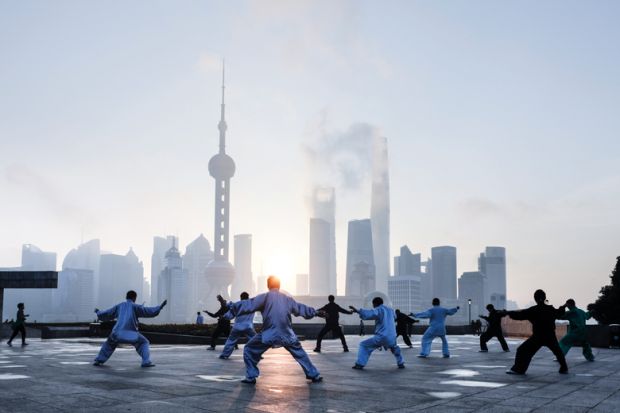China is now on a par with the West in its capacity to service the higher education needs of its own population, a review suggests.
The analysis, by researchers at Tsinghua University’s Institute of Education, shows that China has achieved participation and inclusivity rates to rival those of Europe and North America.
While the article cites eye-popping statistics – including a twofold rise in university numbers, a ninefold increase in enrolments and a 14-fold escalation of scientific papers over the past two decades – overseas observers have become accustomed to extraordinary growth in China’s burgeoning higher education system.
Arguably less familiar are figures suggesting that the country is now a leader on measures that Western university systems typically harness to gauge their own progress.
The paper reports an impressive gender balance, with women constituting 49 per cent of academics and 53 per cent of students in China – compared with 46 and 57 per cent, respectively, in the UK, on latest figures. Although just 31 per cent of China’s full professors were women in 2016, this figure was only marginally below the US’ 32 per cent.
The paper, published in the journal Change, says China’s 55 ethnic minority groups, which constitute 9 per cent of the country’s population, occupy 9 per cent of undergraduate positions. In Australia, by comparison, Indigenous people claim 1.7 per cent of domestic undergraduate places despite comprising 3.3 per cent of the population.
The paper also reports that 46 per cent of 18- to 22-year-olds were enrolled in tertiary education by 2017 – up from about 26 per cent in 2007, 8 per cent in 1997 and 2 per cent in 1978.
Australia is closing in on a recently abandoned target of 40 per cent higher education attainment, while recent figures put the UK and the US participation rates at 50 and 41 per cent, respectively, up from 43 and 39 per cent a decade ago.
The paper’s lead author, Zhou Zhong, said these figures were not necessarily comparable because each country used different age ranges and educational levels to calculate participation rates.
China uses levels 5 to 8 in the International Standard Classification of Education, covering everything from short pathway programmes to PhDs. Dr Zhong said the people included were mainly undergraduate, “but the trend is impressive”.
She said that far from tailing off, China’s participation was likely to accelerate in coming years because the traditional university-age population was shrinking – a legacy of the now-abandoned one-child policy. “Over the next 10 years, the participation rate will grow even if the total enrolment rate stays the same.”
While China’s higher education achievements might be emulating the West in desirable ways, Dr Zhong said, the sector had also borrowed an unwanted characteristic: a penchant for working “996” – 9am to 9pm, six days a week – to meet excessive workloads.
She said that while the term 996 was borrowed from China’s information technology sector, its academic manifestation was fuelled by rankings and “new management” targets for publications, citations and impact factors. “We sort of imported that from the West, and play harder.”
POSTSCRIPT:
Print headline: China ‘matching West’ on participation measures
Register to continue
Why register?
- Registration is free and only takes a moment
- Once registered, you can read 3 articles a month
- Sign up for our newsletter
Subscribe
Or subscribe for unlimited access to:
- Unlimited access to news, views, insights & reviews
- Digital editions
- Digital access to THE’s university and college rankings analysis
Already registered or a current subscriber? Login









